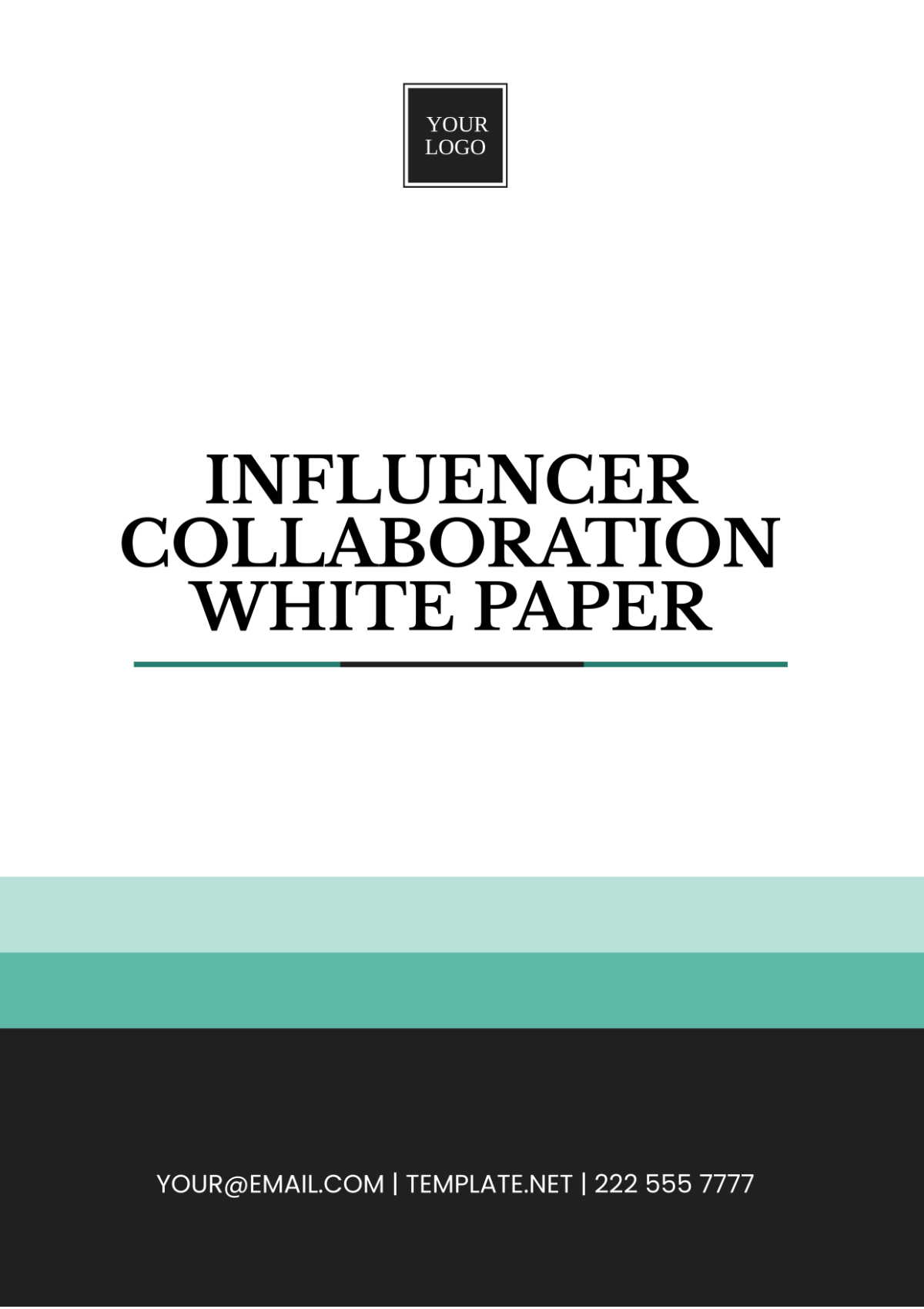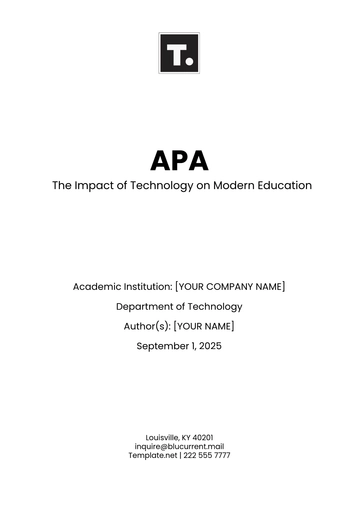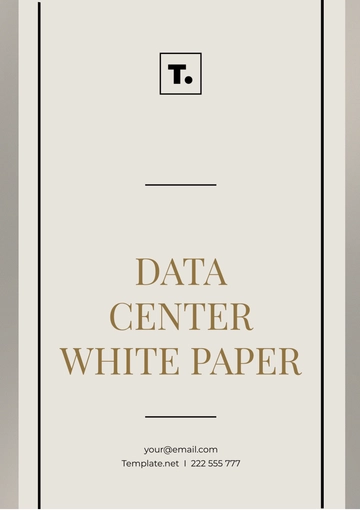Free Influencer Collaboration White Paper

BEST PRACTICE FOR INFLUENCER COLLABORATION IN MARKETING CAMPAIGNS
Prepared by: [YOUR NAME]
Company: [YOUR COMPANY NAME]
Department: [YOUR DEPARTMENT]
I. EXECUTIVE SUMMARY
In today's digital landscape, influencer collaboration has emerged as a powerful tool for brands to connect with their target audience authentically. This white paper aims to elucidate the strategies and best practices essential for successful influencer collaborations. From identifying the right influencers to maximizing reach and engagement, this comprehensive guide equips marketers and influencers alike with the knowledge to foster impactful partnerships.
II. INTRODUCTION

With consumers increasingly seeking authenticity and relatability from brands, influencer collaboration has become a cornerstone of modern marketing strategies. Leveraging the trust and influence of content creators, brands can foster genuine connections with their target audience, driving engagement and conversions like never before.
III. UNDERSTANDING INFLUENCER COLLABORATION
A. Defining Influencer Collaboration
Influencer collaboration encompasses a range of partnerships between brands and individuals with significant online influence. These collaborations can take various forms, including sponsored content where influencers promote products or services, brand partnerships involving long-term ambassadorships, and affiliate marketing arrangements where influencers earn commission on sales generated through their unique links.
B. Benefits of Influencer Collaboration
Increased brand visibility and awareness
Authentic engagement with the target audience
Enhanced credibility and trustworthiness
Potential for viral content creation
IV. IDENTIFYING THE RIGHT INFLUENCERS
A. Target Audience Analysis
Before selecting influencers, brands must conduct a thorough analysis of their target audience demographics, preferences, and online behavior. Understanding the audience's interests and aspirations enables brands to identify influencers whose content resonates authentically with their potential customers.
B. Influencer Selection Criteria
Relevance: Make certain that the content produced and shared by the influencer is in alignment with the core values and specific niche of your brand.
Engagement: Examine and evaluate the engagement metrics of the influencer, which include the number of likes, comments, and shares they receive.
Authenticity: Evaluate the authenticity and genuineness of the content produced by the influencer, as well as the interactions they have with their audience.
Reach: Take into account the extent of the influencer's reach by examining both the number of followers they have and the demographic characteristics of the audience across the platforms they use.
C. Tools for Influencer Discovery
Tools such as Hootsuite, BuzzSumo, and Influence. co offers robust features for influencer discovery, allowing brands to filter influencers based on niche, audience demographics, and engagement metrics. Additionally, social media listening tools like Brandwatch and Mention enable brands to monitor conversations and identify emerging influencers in their industry.
V. ESTABLISHING MUTUALLY BENEFICIAL PARTNERSHIPS
A. Crafting Compelling Collaboration Proposals
Collaboration proposals should articulate the unique value proposition for both the brand and the influencer. Brands should emphasize the benefits of partnership, such as access to exclusive products or services, exposure to a wider audience, and opportunities for creative collaboration. Meanwhile, influencers should be presented with clear expectations, compensation details, and creative freedom to ensure a mutually beneficial partnership.
B. Negotiating Terms and Compensation
Payment: Investigate different compensation strategies such as earning a fixed amount for each post, receiving affiliate commissions, or obtaining products as gifts.
Deliverables: Ensure that you provide a clear and detailed outline of the expected deliverables from the influencer, which should include specifics about the format of the content to be created, the schedule for posting this content, as well as the rights concerning the usage of the content once it has been posted.
C. Building Long-Term Relationships
Beyond transactional partnerships, brands should prioritize building long-term relationships with influencers based on trust, mutual respect, and shared values. By investing in genuine connections and providing ongoing support, brands can cultivate brand ambassadors who are genuinely passionate about promoting their products or services.
VI. MAXIMIZING REACH AND ENGAGEMENT
A. Content Co-Creation Strategies
Theme-Based Campaigns: Collaborate with influencers to create content around specific themes or topics relevant to both the brand and the influencer's audience.
User-Generated Content (UGC): Encourage influencers to involve their followers in content creation through challenges, contests, or branded hashtags.
B. Amplification Tactics
Cross-Promotion: Leverage influencers' existing platforms to cross-promote brand content and reach new audiences.
Paid Promotion: Invest in sponsored posts or advertisements to boost the reach and visibility of influencer collaborations.
VII. MEASURING SUCCESS AND ROI
A. Key Performance Indicators (KPIs)
Engagement Metrics: Track likes, comments, shares, and saves to measure audience engagement.
Reach: Monitor impressions, reach, and follower growth to assess the campaign's overall visibility.
Conversion Rates: Measure the impact of influencer collaborations on website traffic, leads, and sales.
B. Analytics Tools
Tools such as Google Analytics, Sprout Social, and Socialbakers offer robust analytics features to track the performance of influencer collaborations. These tools enable brands to measure key metrics, gain actionable insights, and optimize future campaigns for maximum impact.
VIII. CONCLUSION

In conclusion, influencer collaboration presents a unique opportunity for brands to connect with their target audience authentically and drive meaningful engagement. By following the strategies and best practices outlined in this white paper, marketers and influencers can forge impactful partnerships that resonate with audiences and deliver tangible results. Embrace the power of influencer collaboration and unlock new possibilities for brand growth and engagement.
IX. ADDITIONAL RESOURCES
Case Studies: Explore real-life examples of successful influencer collaborations across different industries.
E-books and Guides: Download comprehensive guides and e-books on influencer marketing best practices and trends.
Webinars and Workshops: Attend webinars and workshops hosted by industry experts to learn about the latest strategies and techniques in influencer collaboration.
X. ABOUT
At [Your Company Name], we specialize in helping brands navigate the dynamic landscape of influencer marketing. With a team of experienced professionals and cutting-edge technology, we empower brands to forge authentic connections with influencers and achieve their marketing objectives. For inquiries and collaboration opportunities, please contact us at [Your Company Email].
- 100% Customizable, free editor
- Access 1 Million+ Templates, photo’s & graphics
- Download or share as a template
- Click and replace photos, graphics, text, backgrounds
- Resize, crop, AI write & more
- Access advanced editor
Enhance and Discover the Influencer Collaboration White Paper Template from Template.net. Crafted for seamless customization, this editable document empowers you to tailor your white paper with ease. Unlock creativity effortlessly as you personalize content in our Ai Editor Tool. Elevate your brand's narrative with this versatile resource, available now for dynamic storytelling.





























